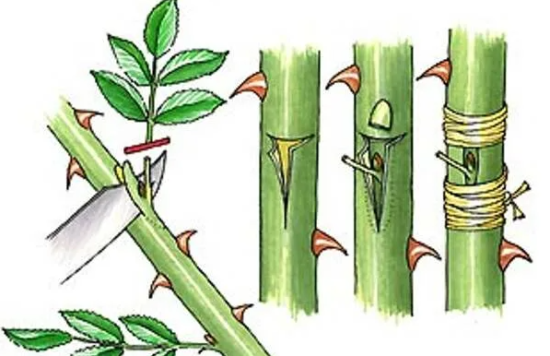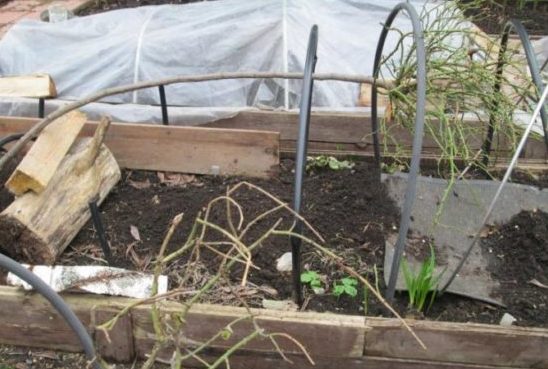Making a standard rose is not at all difficult
When a standard rose settles in the garden, it becomes its sovereign mistress. Possessing a bright appearance and lush hair, a rose bush on a trunk attracts the envious glances of neighbors. A summer resident who has made friends with the thorny queen can be proud that he has conquered the pinnacle of floriculture art.
The low winter hardiness of roses stops inexperienced gardeners from trying to grow standard roses on their plots. Plant experts came to their aid. Through experiments, they discovered that roses grafted onto a bush of unpretentious rosehip show excellent winter hardiness.
What is a standard rose?
The plant does not belong to an independent garden group. This is an ornamental tree consisting of a trunk - a rootstock, usually a rosehip bush (a type of wild rose), and a crown - a scion, from cultivated varieties of roses. She won the hearts of summer residents thanks to the following qualities:
- With early, abundant, repeated flowering throughout the season, like a sorceress, it decorates the area with bright buds;
- With the help of annual pruning, skillful gardeners give the crown of the plant an interesting shape. It can be spherical or weeping;
- The powerful root system of rose hips provides the plant with the necessary nutrition;
- Thanks to the frost-resistant rootstock - rose hips, the standard rose tolerates wintering well. A winter-hardy, zoned variety of rose is chosen as a scion and the grafting site is insulated;
- The crown, located at a decent height from the ground, is well ventilated, which reduces the risk of infection with powdery mildew, rust, and black spot;
How to grow a standard rose with your own hands
|
If you have even a little experience in grafting plants, then creating such standard roses will not be difficult for you |
How to choose the right rootstock and scion for a standard rose (depending on the desired height of the standard)
Depending on the height of the trunk, the following forms of tree rose trunks are distinguished:
- Dwarf (miniature) or mini roses. The length of the trunk is around 50 cm. Suitable for gardeners in the southern regions, since a trunk of such height simply cannot be bent to the ground. In the middle zone, such standard roses are grown as potted plants, and when cold weather sets in, they are brought indoors.
- Half-standards (low). Those with short stature (55-75 cm) are well suited for decorating terraces and decorating balconies.
- Classic (standard). With a height of 80 to 110 cm, they are optimal and look harmonious both in group and single plantings, and are also grown along garden paths. Without much effort they bend down to the ground for the winter. The scion varieties are floribunda, English and hybrid tea roses.
- Weeping (high). The length of the trunk reaches from 140 to 170 cm. The shape received this name due to the long lashes of scions that effectively hang down. Arches and decorative garden structures are gracefully entwined. Not suitable for all varieties of cultivated roses. If you graft a hybrid tea or English rose onto a trunk of such height, it will be difficult to provide proper care. For example, you will have to trim faded buds from the stairs.
The best varieties for grafting
Cultivated rose varieties that are optimal for grafting onto dwarf trunks:
- 'Tom Thumb';
- 'FreshPink';
- 'Rouletti'.
For low (semi-standard) scions, cuttings of rose varieties are used:
- ‘Nina Weibul’;
- 'Iceberg';
- 'Kimono';
- 'Rumba';
- 'SweetDream';
- 'Regensberg' and others.
The following varieties showed good survival rates on classic trunk forms:
- ‘Motley Fantasy’;
- ‘Pussta’;
- 'Landora';
- ‘Caribia’ etc. d.
For rootstocks for tall trunks, varieties of ground cover and climbing roses are used:
- ‘Rosarium Uetersen’;
- 'Kent';
- 'NewDown';
- ‘RougeMeillandecor’.
Preparation of the rootstock (standard)
The rootstock for a standard rose is a rosehip bush (dog rose). Such trunks show good winter hardiness and disease resistance. You can grow it yourself from seeds, which will require 2-3 years of waiting. But the result is worth it. Plants obtained from seeds have increased vitality and a powerful root system.
In order not to wait 3 years, they buy a rosehip bush from a nursery, or dig it up from friends. You should pay attention to the appearance of the seedling. It should be strong, with a large bunch of healthy roots.
Choose a long, even shoot, cut out the rest. The sections are treated with hydrogen peroxide and covered with garden pitch. This will prevent all kinds of infections from entering the wounds. Before planting, the roots of the seedling are renewed by making a shortening cut.
It is better to plant the trunk in the spring, when the soil temperature is not lower than +15°C. If you do it in the fall, the seedling may not take root before frost.
Planting the rootstock
Pets should be placed on the south side of the site, the place should be open, sunny, with a soil composition neutral in acidity. Seedlings are planted using the following techniques:
- The planting hole (65-75 cm) is prepared in advance; drainage - broken brick or expanded clay - is poured onto the bottom. Fill with the following soil mixture:
- 2 parts compost;
- 3 parts fertile soil;
- 1 part sand.
- The seedling is placed in a hole and the roots are straightened. The stem is tilted at an angle of 45° towards the root bend.At the same time, it is taken into account that during the winter the tree will need to be bent to the ground, so the place where the seedling is placed for wintering should be free from other plants. The root collar is buried three cm deep into the soil;
- A strong peg is placed on the side opposite from the slope and a standard rose is tied to it at the top and bottom. To prevent the rope from injuring the bark, place a piece of rubber or a rag folded several times under it. A tying cord is passed in a figure eight between the peg and the trunk;
- Lightly compact the soil and make a watering ditch around the stem. It will prevent water from running off when watering. Having given the tree plenty of water, the planting hole is mulched with grass, hay, sawdust, to prevent crust formation and drying out of the soil. For better survival, the plant is shaded for a month.
Grafting a rose onto a standard with your own hands (by budding and splitting)
Having received the desired standard (rootstock), you can begin the grafting procedure - grafting the eyes of the selected rose varieties onto the trunk. The readiness of the trunk for grafting is determined by the diameter of the root collar (at least 8 mm) and the good separation of the mature bark from the wood.
Two or more varieties of roses are grafted onto one rootstock. In this case, the crown of the tree will be dense, with a head of flowers of different colors. Such a miracle, and even made with your own hands, is guaranteed to attract everyone's attention.
When selecting varieties that will serve as a scion, it is taken into account that the chosen ones have the same flowering time and growth vigor. It makes no sense to graft a bud of a cultivated rose of a powerful, spreading variety onto a miniature rose hip stem, and vice versa.
How to do budding
It’s not difficult to graft a rose with your own hands, just put your heart into it, use your head and boldly get down to business, following the rules of grafting by budding:
- A week before the procedure, if the weather is dry, the rootstock chosen for grafting is saturated with water;
- After watering or early in the morning, cuttings are prepared from mature shoots of cultivated roses. They must be well matured, with dense bark and a thickness of at least 5 mm. The degree of readiness of cuttings for grafting can be checked by trying to bend it. If the scion bends and does not break, it is not yet ripe for budding. Leaves are removed from the branches, and the best eyes are marked in the middle part of the shoot. If you implant a kidney in the spring, in a few weeks you can see the results of your labor;
- Using a sharp, disinfected knife, a T-shaped cut is made on the rosehip trunk at the desired height. A piece of bark with a bud (scutellum) is cut from the donor cuttings. It is inserted into the cut on the trunk, under the bark. It is important that the shield fits tightly into the new place of residence. It should not protrude beyond the boundaries of the transverse cut on the rootstock;
- The grafting site is wrapped with bandages, polyethylene, and electrical tape to ensure better contact between the cambial layers of the rootstock and scion. The eye is not closed; it must remain in the open air. If the operation was successful, after a month the dressing is removed, and in the fall (October) the shoots of the dog rose are cut off above the scion level.
|
The budding procedure is best carried out in the spring, when the plants begin to actively move sap. |
An indicator of a successful budding is a swollen, green, ‘living’ bud a week after grafting. A black, dead kidney indicates an unsuccessful attempt. There is no need to give up; step back a little lower and get the second vaccination.
Grafting rose cuttings onto a standard using the “split” method
There is another way to make a standard rose with your own hands - grafting into a cleft. If budding involves bud grafting, this method will require cuttings. It is used when there is a significant difference in the thickness of the rootstock and scion and includes the following actions:
- At the desired height, the rosehip is cut at an angle of 90°;
- A cut is made in the middle of the formed stump. The selected cuttings of a cultivated variety of rose are cleared of leaves, an oblique cut is made at the bottom and inserted into the split of the rootstock. If the bark is well separated, the cutting of the rootstock can be inserted behind it. The cambia of both parts of the plants should be in close contact with each other;
- The junction of the two plants is wrapped with a bandage, which is not removed until the cutting takes root. To prevent infections from getting into the wound, the grafting site is covered with garden pitch.
|
Grafting rose cuttings onto a standard tree in a split |
After the procedure, the trunk will stop growing in height, but the scion will grow, and the trunk will increase in thickness over time.
Caring for a rose after grafting
A plant that has undergone surgery to implant a donor experiences some degree of stress. During this period, it is worth providing it with proper care, then the bush will quickly come to its senses and immediately begin to grow:
- Watering. The standard rose bush is a water feeder; you need to water it regularly and abundantly, at least 1 bucket of water per plant;
- Feeding. In spring, a full range of mineral fertilizers are applied to the bush. Be sure to provide nitrogen, they stimulate the growth of the seedling. In August-September, they are treated with potassium salt and superphosphate so that the plant can successfully overwinter;
- Trimming. To obtain a cap in the popular cup-shaped form, all shoots on the rootstock that appear as the seedling grows are removed.One-year growth is cut in half above the bud, which faces the center of the bush. The remaining branches are shortened by a maximum of 5 buds. All sections are treated with garden varnish or disinfectant paint;
- Loosening. To ensure free access of oxygen to the roots, the tree trunk circle is periodically loosened, especially after watering. To prevent the evaporation of moisture from the soil and protect it from drying out, the ground around the seedling is mulched with natural materials (hay, sawdust, mown grass).
Do not miss:
Preparing a standard rose for wintering
Before the onset of frost, the bush is watered abundantly one last time, making a powerful moisture-recharging watering. When frost occurs, the water in the voids of the root system turns into ice. This will prevent the roots of the seedling from freezing.
A bare (without leaves and flowers) plant is treated with iron sulfate or Bordeaux mixture to prevent disease.
Having freed the root collar from the ground, the stem of the grafted rose is bent to the soil in the direction opposite to the scion. Secure in several places with retaining staples.
|
It is important to prevent the plant from coming into contact with the ground, otherwise in the spring the bark will become warm and the seedling will freeze. Spruce branches and dry foliage are placed under the trunk and crown. A layer of the same plant materials is placed on top, and the crown is wrapped in burlap. |
The final stage of the shelter will be the construction of a frame over the bent and covered pet. It can be made from boards or metal arcs. Stretch lutrasil, agrofibre or burlap over the top.
Care and formation of standard roses in subsequent years
Growing and caring for standard roses is not much different from growing ordinary roses.There are noticeable differences only in trimming.
In the spring, pruning is carried out. Floribunda, hybrid tea, and miniature varieties cannot be trimmed very short. In this case, only a few powerful shoots will appear, sticking out in different directions. With proper pruning, 5-6 buds are left. In climbing and ground cover roses, those vines that have bloomed are cut out completely, the rest are shortened in length.
All types of standard roses undergo sanitary pruning, cutting out frozen, broken, diseased lashes.
The shoots that appear during the season are removed; they take away excess strength from the seedling. From the beginning of summer, the plant begins to form buds and bloom. The resulting beauty must be treated against diseases and pests. Standard roses respond well to foliar feeding and feeding with mullein. Having fed the plant with it, it will thank you with several waves of flowering with a large number of buds. During the flowering period, wilted inflorescences are removed so as not to spoil the beauty.
Growing a standard rose with your own hands is not difficult. Having made friends with her, on a small piece of land they get a gorgeous flowerbed of roses on a leg. With proper care it will delight its owners for several years.





 CUCUMBERS NEVER GET SICK, I'VE BEEN USING ONLY THIS FOR 40 YEARS! I SHARE A SECRET WITH YOU, CUCUMBERS ARE LIKE THE PICTURE!
CUCUMBERS NEVER GET SICK, I'VE BEEN USING ONLY THIS FOR 40 YEARS! I SHARE A SECRET WITH YOU, CUCUMBERS ARE LIKE THE PICTURE! You can dig a bucket of potatoes from each bush. Do you think these are fairy tales? Watch the video
You can dig a bucket of potatoes from each bush. Do you think these are fairy tales? Watch the video
 How our fellow gardeners work in Korea. There is a lot to learn and just fun to watch.
How our fellow gardeners work in Korea. There is a lot to learn and just fun to watch. Eye trainer. The author claims that with daily viewing, vision is restored. They don't charge money for views.
Eye trainer. The author claims that with daily viewing, vision is restored. They don't charge money for views. A 3-ingredient cake recipe in 30 minutes is better than Napoleon. Simple and very tasty.
A 3-ingredient cake recipe in 30 minutes is better than Napoleon. Simple and very tasty. Therapeutic exercises for cervical osteochondrosis. A complete set of exercises.
Therapeutic exercises for cervical osteochondrosis. A complete set of exercises. Which indoor plants match your zodiac sign?
Which indoor plants match your zodiac sign? What about them? Excursion to German dachas.
What about them? Excursion to German dachas.